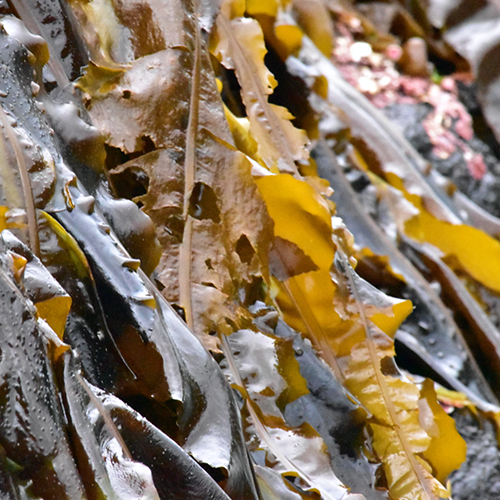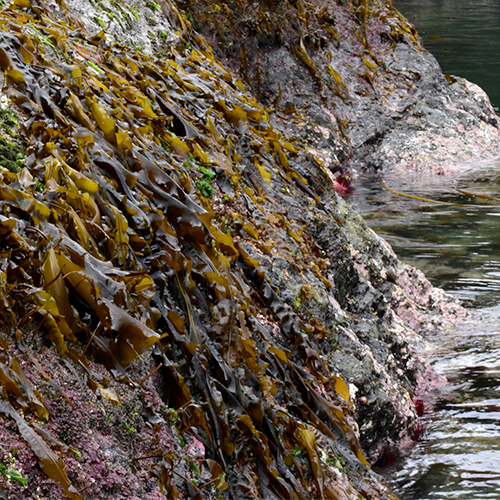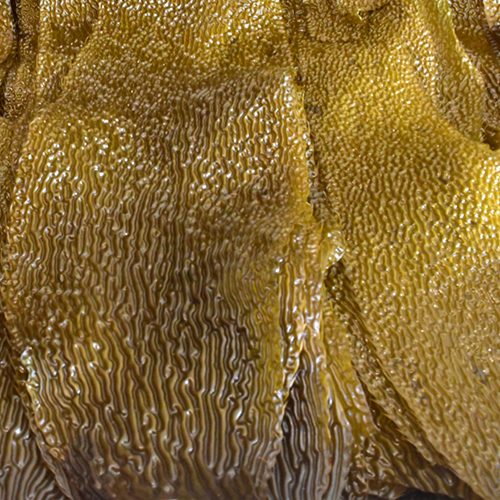Our kelp products have earned a name for themselves ever since we started offering kelp in 2020. They’re sustainable, healthy, hand-harvested by your kelper, Dafne Romero, in Haida Gwaii. In this blog you’ll learn more about our Wakame Flakes, Kombu Flakes, and Giant Kelp Mini Flakes. Read on for our “Kelp 101” including how each type of grows, some nutritional benefits, and recipe ideas!

Wakame Kelp
Wakame kelp (Alaria marginata) can grow up to 4m and is visually quite different from giant kelp as the blades are long and narrow. They are a perennial plant which can live up to 5 years in optimal conditions. They have even been known to live up to 7 years on occasion! The maximum growth rate happens in April and May when they grow by 20cm per month, but once June and July roll around, that growth rate slows down. Wakame is also rich in B vitamins, including B12, as well as vitamins A, C, K and E and the minerals such as calcium, magnesium, manganese, iodine, iron and phosphorus.
To prepare your wakame flakes, you can hydrate them by boiling in water for 10-20 minutes, or you can soak them in cold water for 30 minutes. Adding a bit of rice wine vinegar helps to tenderize them, too! Wakame can be prepared as a seaweed salad, in miso soup or even as a wakame pesto. Some of Dafne’s personal wakame recipes include this Alaria Capra Salad, and this Marinated Alaria Salad!

Kombu
Kombu (Laminaria saccharina) can grow up to 7m, and are short-lived perennials, with blades that generally only survive for 6-8 months. They grow about 1.1cm per day and the entire plant usually doesn’t live past 4 years old. Kombu is naturally rich in vitamins, minerals, and healthy fats – while being low in calories!
Kombu flakes are really amazing when added to soups, broths, beans, and even in savoury oatmeal. Just add 2-3 flakes to any simmering liquid for a nutrient boost! The leftover kombu flakes can then be simmered to tenderize them, and then topped over rice. Kombu flakes can be used to make dashi, added to kimchi, or wrapped around fish or meat.

Giant Kelp
Giant kelp (Macrocystis pyriferia) is actually one of the fastest growing organisms on Earth. In fact it can grow as much as 60cm a day and reach over 45m in a single growing season! The kelp blades (or fronds) only last for a few months, as the blades are exposed to significant wave action and grazing animals.
Giant kelp can be used in soups, stir frys, lasagna, avocado toast, eggsand lots more. It is also great sprinkled with olive oil on a baguette! A super unique way to enjoy these Giant Kelp Mini Flakes is in this delicious Kelp Brownie recipe from Chef Ned Bell.
Giant kelp is a leading source of iodine, which is a mineral that is essential for healthy thyroid function. These nutrient-dense flakes are a natural source of vitamins A, B1, B2, C, D and E and are rich in marine minerals including potassium, magnesium, calcium and iron.
If you would like to add some of Dafne’s kelp to your next order, simply login to the Dock! We’re excited to see what you make with it, and please send us recipes and photos of your creations! Not a member yet? No worries! Sign up is open until May 31st, so become a member now!
Allison Hepworth - April 1, 2022






